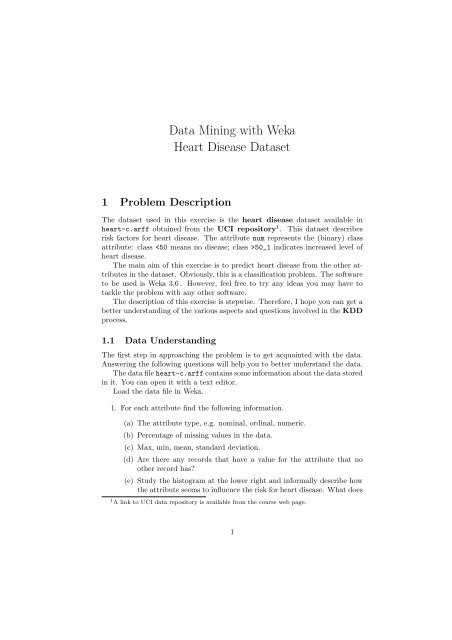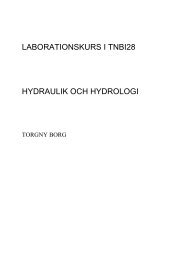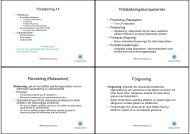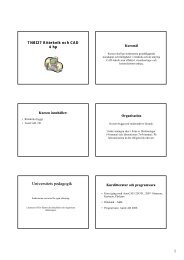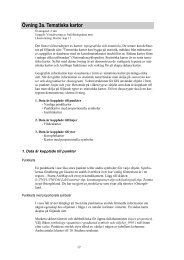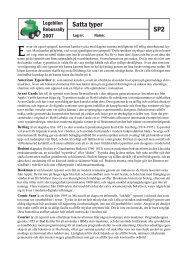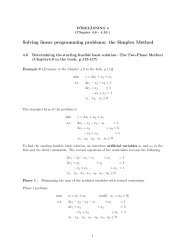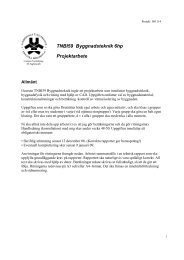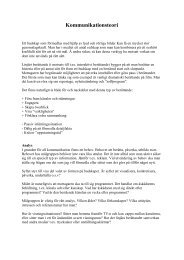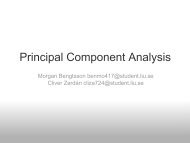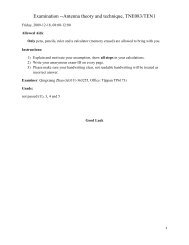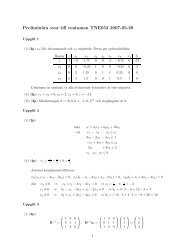Data Mining with Weka Heart Disease Dataset
Data Mining with Weka Heart Disease Dataset
Data Mining with Weka Heart Disease Dataset
You also want an ePaper? Increase the reach of your titles
YUMPU automatically turns print PDFs into web optimized ePapers that Google loves.
<strong>Data</strong> <strong>Mining</strong> <strong>with</strong> <strong>Weka</strong><strong>Heart</strong> <strong>Disease</strong> <strong>Data</strong>set1 Problem DescriptionThe dataset used in this exercise is the heart disease dataset available inheart-c.arff obtained from the UCI repository 1 . This dataset describesrisk factors for heart disease. The attribute num represents the (binary) classattribute: class 50_1 indicates increased level ofheart disease.The main aim of this exercise is to predict heart disease from the other attributesin the dataset. Obviously, this is a classification problem. The softwareto be used is <strong>Weka</strong> 3.6 . However, feel free to try any ideas you may have totackle the problem <strong>with</strong> any other software.The description of this exercise is stepwise. Therefore, I hope you can get abetter understanding of the various aspects and questions involved in the KDDprocess.1.1 <strong>Data</strong> UnderstandingThe first step in approaching the problem is to get acquainted <strong>with</strong> the data.Answering the following questions will help you to better understand the data.The data file heart-c.arff contains some information about the data storedin it. You can open it <strong>with</strong> a text editor.Load the data file in <strong>Weka</strong>.1. For each attribute find the following information.(a) The attribute type, e.g. nominal, ordinal, numeric.(b) Percentage of missing values in the data.(c) Max, min, mean, standard deviation.(d) Are there any records that have a value for the attribute that noother record has?(e) Study the histogram at the lower right and informally describe howthe attribute seems to influence the risk for heart disease. What does1 A link to UCI data repository is available from the course web page.1
(b) Investigate the possibility of using (linear) regression to estimate themissing values for each attribute. Save the dataset you obtained<strong>with</strong>out missing values in the file heart-c3.arff.3. Eliminating outliers.Eliminate the outlier records and save the dataset you obtained <strong>with</strong>outoutliers in the file heart-c34.arff.1.3 <strong>Mining</strong> the <strong>Data</strong>The third step is to use some classifier algorithms available in <strong>Weka</strong> to discoverhidden patterns in the data.You should repeat the steps described below for each of the datasets youcreated during preprocessing, besides using also the original dataset (if possible).1. Start <strong>with</strong> OneR classifier.(a) What can you conclude? Compare your conclusions <strong>with</strong> your previousconclusions obtained in section 1.1.(b) Compare the accuracy of the classifier on the training set <strong>with</strong> theaccuracy estimation obtained through 10 fold-cross validation. Howdo you explain the difference (if any)?2. Use JRip classifier, i.e. the <strong>Weka</strong> version of the rule classifier RIPPER.(a) Build a classifier <strong>with</strong> and <strong>with</strong>out rule pruning. Which one is preferable?Motivate your answer.(b) Describe the patterns you obtained and compare <strong>with</strong> your previousconclusions.3. Use J48 classifier, i.e. the <strong>Weka</strong> version of the decision tree classifier C4.5.(a) Investigate the use of different J48’s parameters such as pruning andminimum number of records in the leaves.(b) Describe the patterns you obtained and compare <strong>with</strong> your previousconclusions.1.4 Clustering TendencyInvestigate whether there is a clustering tendency in the dataset. You may startby clustering the data <strong>with</strong> SimpleKMeans algorithm, for some 2 ≤ k ≤ 10.1. Do not use the class attribute, num, for clustering.2. Find a suitable value for k, i.e. the number of clusters you are going tobuild. Justify your choice of k.3. Use class to cluster evaluation and make sure that standard deviations arealso computed for numerical attributes.3
4. Study the numerical measures displayed by <strong>Weka</strong> for each cluster. Whatcan you conclude?5. Use Visualize cluster assignments and try to discover a descriptionfor each cluster.6. Investigate the possibility of building a classifier for finding rules describingthe clusters. Compare the results <strong>with</strong> your previous conclusions.7. Investigate the possibility of using the cluster information to build a classifierfor num. Compare your results <strong>with</strong> what you obtained in section 1.3.Do you get a better classifier?1.5 Predicting PerformanceIn the previous step you have built several models. Finally, you need to comparethe different models and describe your final conclusions.1. <strong>Weka</strong> outputs several performance measures. Choose some of the performancemeasures and motivate your choice.2. Summarize in a table the performance measures for each classifier andeach dataset.3. What can you conclude?1.6 ConclusionsDescribe your final conclusions and indicate which risk factors for heart diseasehave you found in the data.4


